
9. X-Pigeons |
||||
Bh - Baldhead Pied
Although there are many other “piebald” or simply referred as “pied” phenotypes in variety of pigeon breeds with variety of colors and patterns, the mutation under discussion here is baldhead pied. I will talk about the other pied phenotypes later in this page. We don’t really understand how any of the piebald (including baldhead pied) mutations work yet in detail. Baldhead pied mutation and its phenotype has been debated for years but it is generally white headed, white flighted, and white tailed phenotype. Some argue that the tail is not part of the baldhead package, and it is a recessive trait compared to dominant head and flight mutations. However, no one ever produced any scientific work about baldhead pied patterns in pigeons to prove their claims, their casual observations, or their opinions in this matter. One of the main reasons why pied phenotypes show so many different varieties is because most pied birds are combinations of at least three or four different genes. Piebald is genetically complex mutation with very little published data probably because it is such a ghastly mess. “Keep in mind that baldhead isn't so perfectly managed like, say, indigo, or brown mutations and some white-headed pigeons do not carry the genotype of the symbolized baldhead – Bh,” says Robert Mangile (private communication). Let’s look at how the expression of a good baldhead pied supposed to be for the perfect baldhead pied phenotype. I am using a West Of England Tumbler picture as an example here, but keep in mind that the standards we are about to discuss applies to any show quality pigeon breeds.
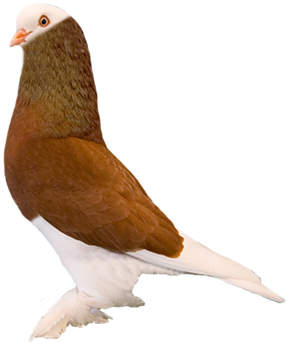 The
most valuable property to look for and it is the most difficult
to get in a Bald, is being a clean cut as it is called; that is,
that the white on the head from which it is named should be divided
from
the body-color by a sharp clean line. This line should
pass just below the eye to but little under the beak; and when the
bird is correctly marked it is said to be "high cut". If
the white extend lower, or at least very perceptibility lower than
this, the
bird is
described as "low cut", and considered to be not a good
Bald. It is however, very seldom that birds are seen quite so high
cut or
clean
cut. It
is not unusual at all to see some birds where its owner assisted
nature a little by removing a few feathers skillfully as to make
the bird
appear as if clipped all round to a pattern. The term “clean
cut” was derived from this practice. Some exhibitors, instead
of pulling the feathers out – a process which needs repeating
as they re-grow – cut
them off close the skin which last till the next molt. In his book, “Origins
and Excursions in Pigeon Genetics, p.117,” Hollander points
out that fanciers have learned repeated plucking of feathers (especially
in
recessive red birds) will eventually result in the growth of white
ones. Injury to the skin, with resulting scar tissue, also may produce
white feathers. Certain nutritional
deficiencies and hormonal upsets may also result whiteness and the general
term
for such whitening
is called “achromatosis”. Clean-thighed, which is the
line just below the breast and above the thighs the color
of the body should cease at a sharp tranverse
line
running right across, is another important property of the Baldhead
pied phenotype. The white in the thighs is expected to be pure,
and unmixed with colored feathers. The number of white flight-feathers
which should be 10x10
in the wings is another important property of Baldhead pied.
However, this is also a rarely seen condition. It is pretty easy
to get
something
like
10x8 or 9x7 and still have OK shield marks but fanciers experience
that when they try for 10x10 the birds get way too white. The
usual average is six, seven, or eight on each side, and very frequently
more on one side than the other. Flight-feathers is a property
no “dodging” can
imitate, as, if the colored flight be pulled out, the deficiency
is easily discovered by counting. The tail feather of the baldhead
should also be pure white with no exceptions as the judge will
count the tail feathers.
The
most valuable property to look for and it is the most difficult
to get in a Bald, is being a clean cut as it is called; that is,
that the white on the head from which it is named should be divided
from
the body-color by a sharp clean line. This line should
pass just below the eye to but little under the beak; and when the
bird is correctly marked it is said to be "high cut". If
the white extend lower, or at least very perceptibility lower than
this, the
bird is
described as "low cut", and considered to be not a good
Bald. It is however, very seldom that birds are seen quite so high
cut or
clean
cut. It
is not unusual at all to see some birds where its owner assisted
nature a little by removing a few feathers skillfully as to make
the bird
appear as if clipped all round to a pattern. The term “clean
cut” was derived from this practice. Some exhibitors, instead
of pulling the feathers out – a process which needs repeating
as they re-grow – cut
them off close the skin which last till the next molt. In his book, “Origins
and Excursions in Pigeon Genetics, p.117,” Hollander points
out that fanciers have learned repeated plucking of feathers (especially
in
recessive red birds) will eventually result in the growth of white
ones. Injury to the skin, with resulting scar tissue, also may produce
white feathers. Certain nutritional
deficiencies and hormonal upsets may also result whiteness and the general
term
for such whitening
is called “achromatosis”. Clean-thighed, which is the
line just below the breast and above the thighs the color
of the body should cease at a sharp tranverse
line
running right across, is another important property of the Baldhead
pied phenotype. The white in the thighs is expected to be pure,
and unmixed with colored feathers. The number of white flight-feathers
which should be 10x10
in the wings is another important property of Baldhead pied.
However, this is also a rarely seen condition. It is pretty easy
to get
something
like
10x8 or 9x7 and still have OK shield marks but fanciers experience
that when they try for 10x10 the birds get way too white. The
usual average is six, seven, or eight on each side, and very frequently
more on one side than the other. Flight-feathers is a property
no “dodging” can
imitate, as, if the colored flight be pulled out, the deficiency
is easily discovered by counting. The tail feather of the baldhead
should also be pure white with no exceptions as the judge will
count the tail feathers.
The eyes are one of the most important properties where it can cost the bird to be not perfect even if the other parts are clean. The eyes should be pearl as opposed to bull, orange, cracked, or odd colored eyes. In fact, breeders will discard a bird, counting it of little or no value if the bird is bull-eyed or broken-eyed. It is undoubtedly a great fault, and one which will prevent a bird wining against good birds. It is very difficult to naturally producing a Bald with the above descriptions and expectations to be called a perfect Baldhead but those are the standards the fanciers are trying to produce.
Now, let’s look at other piebald phenotypes. Any patchwork mixture of white and colored plumage is termed “piebald,” which includes baldhead, badge, beard mark, saddle, magpie, bell neck, ring neck, pencil, gazzi, white flights, white tails, etc., all showing a distinct piebald condition, and the white and colored areas differing in the various breeds. These phenotypes are suspected to be combinations of pied factors - two or more mutations. Piebald is generally considered a solid white patch surrounded by color or a solid-colored patch surrounded by white. However, piebalds should not be confused with things like grizzle or most scattered white feathers on an almond pied. In his book, “The Pigeon,” Wendell Levi suggests that the large number of fixed piebald types, the production of piebalds from crosses of self white and colored, and the difficulty of classifying the “splashed” specimens, are signs enough that the genetics of piebaldness is not simple. Levi states: “Numerous half-hearted attempts to analyze the matter have been made, none very conclusive. If disorderly, it is more often called ‘splashed’, but selective breeding has fixed certain patterns fairly permanently in the many domestic breeds. It appears to have been simply a matter of taste among the breeders of the past, every conceivable arrangement being demonstrated by breeds” (Levi, The pigeon, p.315).
Piebald is probably one of the most genetically complex mutations found in pigeons, and it is very poorly understood. When studying genetic science, to back up a claim, evidence must be presented and reviewed. The only well documented and well understood piebald phenotypes are gazzi, pencil and recessive white, and the rest of the variants are nothing more than meaningless speculations that are not understood by anyone. The fact is we can clearly observe that some piebalds are dominant, some are recessive and some change with age, starting out colored and turning white gradually. There is also a dominant baldhead pied. However, no one knows how many genes, switches, or promoters are involved in these variants of piedball phenotypes and no one supplied any breeding data to support their observations. Sadly, we haven’t learned anything about piebald in the last 60 years other than W. F. Hollander's work showing that recessive white was a single gene and Robert J. Mangile's work showing that gazzi and pencil are alleles of recessive white. Those are the only well documented data we have for piedball and white plumage.
Piebald phenotype variants have been known for so long, and therefore, must be very old, since they are spread over nearly all domesticated breeds. Piebald mutation in Ringneck doves was first reported by Bernard Roer of Pheonix, Arizona in 1957, where Roer first bred them and then sold them. And by 1965, Ringneck piebald birds began to get around the country and were first publicized by Richard E. Burger in May 1967. In 1979, Hollander and Miller published “The Story of the Pied Mutation” and concluded that pied mutation is not sex-linked, but is a simple recessive mutant. However, they admitted that it is not very simple and breeders may easily be confused. Hollander later suggested in “Origins and Excursions in Pigeon Genetics” that the baldhead pattern seems to be a probable unit that shows incomplete dominance to self. Even hybrids of baldhead with ringneck dove show fair piebaldness. Hollander also adds that the ordinary bull-eyed self white can be regarded as an extreme pied: pigmentation limited to the inside of the eyes. When Hollander was talking about “Delusions of Genetics”, he mentioned how problematic white and pied are in his sarcastic way of explain things in laymen’s terminology. “The biggest headache of this sort is the white and pied effects. Not only is each of these a slippery customer, but the relationships among them are very tedious to work out. The solitaire game here isn’t enough-a large scale exploring expedition needs to be equipped!” (Hollander, Origins and Excursions in Pigeon Genetics, p. 25).
When discussing pied phenotype we should wonder why does one pied bird look say three-quarters white, while another is only maybe one quarter white? Why don’t they all look the same? Shouldn't they be put into different classes? We should also notice that as with other mutants, the way piebald handles in one flock might be different in another which creates a lot of varieties and more confusions among fanciers. Joe Quinn emphasizes the difficulty of identifying and describing the piebald as well: “Piebald is a loosely defined term, describing the alternation of two colors. Pigeon breeders use the term collectively to identify a series of white forms that have been somewhat standardized by generations of selection. Segregation of phenotypes in piebald matings to wild-type is difficult to analyze. White flights are probably produced by a gene or genes of a dominant type” (Quinn, The Pigeon Breeder’s Notebook, p. 107).
Possible explanations and causes of piebald phenotypes:
According to Dr. Cryberg, most of what is known about piebalds comes from work with mice. “My guess is the biochemistry that leads to white feathers has dozens of different details. That is what the mice work shows and mice are far simpler than pigeons,” says Dr. Cryberg (private communication).
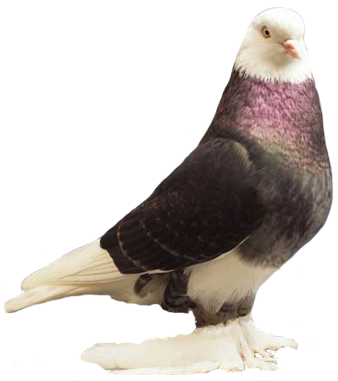 According to Levi, the
skin areas of a young piebald bird are pigmented in correlation with
its feather areas. The skin of the tarsi of a baby
piebald (six-seven days of age) is frequently white and black-pigmented,
forecasting its future feather color. So, the skin of the head of a
baby black Nun is black while the skin of its body is white. Robert
Mangile points out that piebald can be expressed by a "single" white/light
toenail on an otherwise wild-type phenotype; or, perhaps by a broken
bill ring on a newly hatched squab (private communication).
According to Levi, the
skin areas of a young piebald bird are pigmented in correlation with
its feather areas. The skin of the tarsi of a baby
piebald (six-seven days of age) is frequently white and black-pigmented,
forecasting its future feather color. So, the skin of the head of a
baby black Nun is black while the skin of its body is white. Robert
Mangile points out that piebald can be expressed by a "single" white/light
toenail on an otherwise wild-type phenotype; or, perhaps by a broken
bill ring on a newly hatched squab (private communication).
In “Origins and Excursions in Pigeon Genetics,” Hollander suggested that some serious and advanced tests are required for us to fully understand the causes of piebald phenotypes: “Genetic analysis of the pied varieties is likely to require an extraordinary amount of time, patience and effort. And we will want to know what is the development basis, in terms of the melanocytes. Are they just few in numbers at the start of their embroyonic migration, so that some areas are not invaded? Or is this or that area not favorable for melanocytes to live in. Can embroyonic conditions such as high or low temperatures or egg yolk quality or air pollution perhaps favor or inhibit melanoctye activity? Interesting experiments await” (p. 118).
What causes the white plumage and consequently the white patches found in pied phenotypes? Melanocytes are melanin-producing cells located in the bottom layer of the skin's epidermis. Melanin is a pigment that is primarily responsible for the color of skin and the color of feathers. Through a process called melanogenesis, these cells produce melanin. “The cells called melanocytes, are migratory at first, coming from embryonic neural tube and eventually populating all the skin and even the eyes. When feather begins to grow, melanocytes invade the structure and settle down, looking like dark spiders, full of pigment granules. As the feather dries the cells die but the pigment remains. Therefore, to get white feathers, either the melanocytes would have to be prevented from migrating in, or their pigment synthesis would have to be inferred with” (Hollander, Origins and Excursions in Pigeon Genetics, p. 117).
Joe Quinn also attempted to tackle on this very complex problem, i.e., causes of piebald in pigeons. "In pigeons, I suggest at least forty separately-caused white conditions exist. Each form of white has its own peculiar impact-time, action-site and mode of effect. Breeders should handle white phenotypes with great care, least they compound several forms in the same phenotype and produce unbelievable variations in expressions. The prevalence of white in pigeons is so extensive, that the breeding art requires some understanding of this complex subject. Different areas of the pigeon tend to have different pigmentation densities and the distribution tends to be symmetrical. The migration of pigment cells is clearly a timed process. It must take place within specific time phase of embryonic growth. If migration is slowed for some reason within a specific time phase, certain areas will not have resident cells and white will result. Since some migrational or environmental changes take place after hatching, a few white forms are related to the aging process. In this case, changes in the local tissue environment are usually responsible for the white expression" (Quinn, The Pigeon Breder’s Notebook, p. 104).
Although we are witnessing so many different versions of pied phenotypes, evidence suggests that several mutants can cause much the same pattern, which makes the study of pied subject even uglier. For instance, the bald head mutant in Mookees is found to be recessive, where the Roller version of the bald head is seems to be a weak co-dominant. The breeding data on the bald head Russian Trumpeters on the other hand, shows dominance to wild-type. In addition, our current understanding of DNA and mutation suggest that there cannot be forty or more different DNA mutations of pied patterns alone, therefore epigenetics seem like a more reasonable explanation of the various pied patterns found in pigeons.
In an article written by Dr. Richard Cryberg “Biosynthesis of eumelanins and pheomelanin”, Dr Cryberg states: “The white areas in piebald are the result of things like differential and selective migration of melanocytes in the embryo or with programmed cell death of melanocytes and not with turning pigment synthesis on in some regions of the birds body and off in others. In piebald variants the feathers in an area are either white or colored. The colored areas of pied are governed by the rules given herein including those where the colored feathers show both color and white.” Dr. Cryberg, suggests it is possible that a lot of our pieds happen with the programmed cell death of melanocytes. If melanocyte cell death happens by the time the egg hatches, you cannot tell that the melanocytes were ever there unless you look at tissue samples of the embryo before hatching. "I am pretty sure this is what causes recessive red white sides. They have normal colored shields in nest feather and then molt white,” says Dr. Cryberg (private communication).
The problem with trying to do anything with piebalds in pigeons is very difficult and it is a very complex problem. We know that there are both dominant and recessive white flights and also dominant and recessive white tail feathers. This creates a problem where most of them by themselves give a range of phenotypes rather than always the same thing. No one has any standard birds to run breeding experiments on these genes and therefore, it makes it even harder for us to understand how many different genes are responsible for piebald phenotypes. Piebald is simply so complex that trying to work on it by breeding experiments and get decent answers is generally a waste of time. In addition, there are a lot of piebald genes and it is very hard to numerate them all. In fact, it appears that there are at least three genes involved in piebald just in the tail and some data on Helmets suggest that at least three piebald genes and possibly more are found in that breed alone. According to Dr. Cryberg piebald is a lot more complex than we can possibly begin to understand: “To make matters worse some of those pied genes do not even show when homozygous if they are by themselves. So trying to make sense just from breeding studies is near hopeless unless you are willing to raise hundreds of young,” says Dr. Cryberg (private communication).
Piebald Examples In Various Pigeon Breeds: The following pictures are taken from the National Pigeon Association Website.
 |
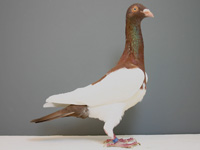 |
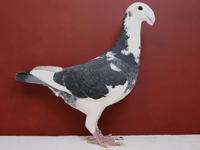 |
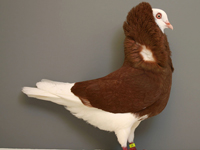 |
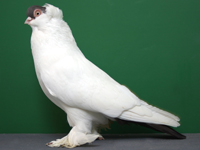 |
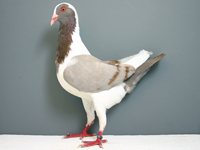 |
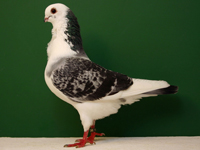 |
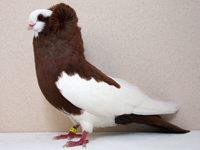 |
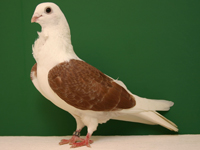 |
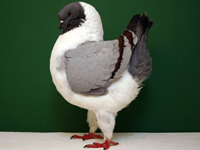 |
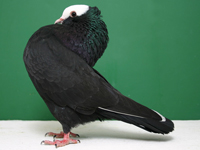 |
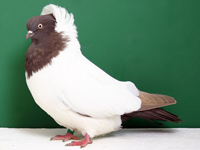 |
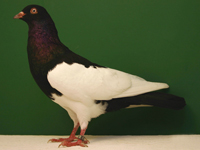 |
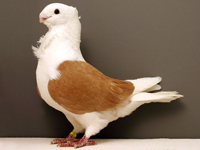 |
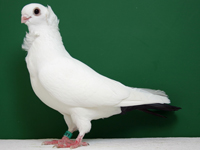 |
 |
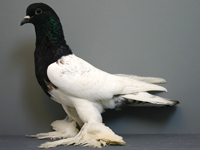 |
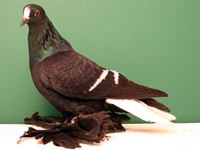 |
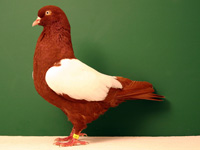 |
 |
Bull eyes on pied birds are another mystery. Some pied birds come with bull eyes which we normally see in recessive white birds, and some don’t. It is important to notice that pied birds with baldheads (white heads, that includes badge and beard mark) seem to show all colored eyes (orange, pearl, and bull), where some pieds like Gazzi, Magpie, Helmet, or Nun etc. come with orange or pearl eyes only, although there are some exceptions of bull eyes on self colored birds. Selection for colored eyes (specifically preferred pearl eyes for the show quality birds) seems to suggest that whatever governs melanocyte migration differs a bit between the skin and the eyes based on the pearl/orange eyes compared to bull eyes. Another interesting thing to notice is the beak color on certain pied birds. The usual expectation is that white heads goes with white beaks and dark heads go with darker colored beaks. White or light toenail on an otherwise wild-type phenotype is another expected result we observe in the pied birds which we normally see in recessive white phenotypes. We don’t understand the reasons why piebalds come with variety of eye, toenail, or beak colors either, but epigenetic as opposed to a DNA difference seems more reasonable explanation to these phenomenon.
As roller breeders and competition flyers, we concentrate on pied rollers purposely because the white flights and the white tails create an illusion which makes the spin of the bird look a lot faster. This is because the wings of the white bird have very little contrast to the sky, leaving no comparison point to judge the speed of the rotating body with the speed of the wings. Furthermore, on a dark bird, the wings and tails, while spinning, are seen against the sky, leaving a comparison to the body of the bird that allows you to judge the speed more accurately. Because of that, rollers are loaded with pied patterns. What is really interesting with rollers is that some bald head, badge, or beard marks have one bull and one orange/pearl eye, which may suggest that pied mutations found in rollers are co-dominant or hetero recessive white is involved.
Most biologists will agree that pied is not one of the beneficial mutations found in pigeons and white plumage is usually a disadvantage in the wild. However, the study done by Albert Palleroni of Harvard University and three colleagues report that the pigeons with the white patch often found on the rump stand a better chance of getting away. When the pigeon predator zooms in from behind, the white patch somehow distracts the peregrine falcon. The scientists reasoned that the white patch might be an evolutionary adaptation that helped its inheritor to live longer and procreate more, while the bird that could no longer show the white feather fell victim to peregrine, showing less chance of survival. The only unknown or unproven claim now is that the white rump is part of pied mutation because if it is, we can argue that this particular pied mutation is actually is a beneficial mutation to pigeons.
In conclusion, the study of white plumage inheritance is very complex especially in pigeons. One of the problems is that unlike pigmented feathers and mutations, white is always the same, and it takes a lot of words to describe the expressions of various piebald patterns. In addition, none of the piebald patterns express themselves exactly the same way in all breeds of pigeons. More importantly, in some of the piebald patterns of the named breeds it is almost a certainty that the patterns are produced by a combination of mutants (piebald patterns) which makes it a lot harder to study and sort these genes of mutations. It seems, that the pied mutation in pigeons starts with white flights only, and then gets into head and tail, creating bald head, badge or beard marked phenotypes. Then it gets saddle or magpie to ring neck and bell neck patterns. Therefore, we can argue the actual reason why pied phenotypes occur is because inbreeding done by the fanciers that capitalized on them and when breeders begin to "propagate" them we get to see various pied phenotypes. We notice that in pigeons, by mating piebald patterns together, the white plumage increases in the offspring, especially when multiple mutations are involved. In the case of gazzi, or penciled, we see the opposite of baldhead pieds, where the head, flights and tails stay pigmented and other feathers on other parts of the body get white feathers. Currently we don’t understand much about these complex phenotypes except to call them piebald phenotypes.
Piebald Phenotype Examples of Other Animals:
Color variations in all animals are caused by a lack of certain pigments or melanin in the skin of the animal. This genetic "defect" is caused by certain sequences of DNA which are not normally active becoming active in the development of the animal. It is very similar to albinism, which is a lack of pigmentation in the skin, causing a whitish color. Dogs, birds, cats, pigs, dairy cattle and many other animal species may also be "pied" or piebald. Snakes, especially ball pythons, may also exhibit seemingly varying patches of completely pigmentless scales along with patches of pigmented scales. The bald eagle derived its name from the word "piebald," in reference to its white head and tail contrasting with its dark body. Notice that piebalds are extremely variable in appearance in many different species. Click on each picture to enlarge them.
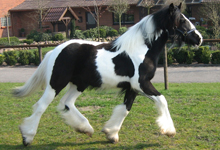 |
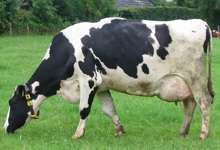 |
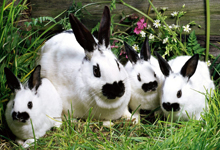 |
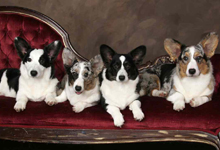 |
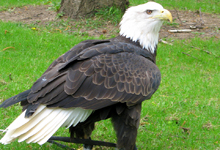 |
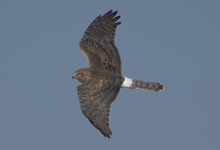 |
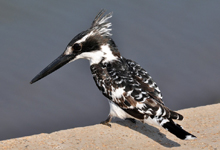 |
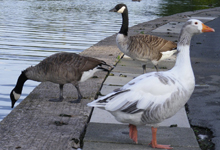 |
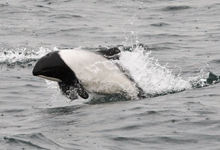 |
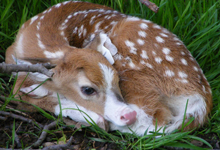 |
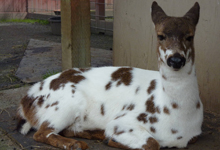 |
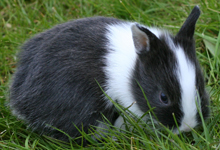 |
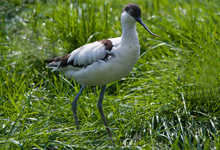 |
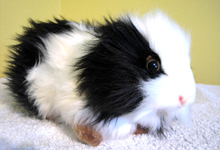 |
 |
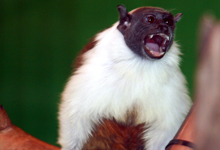 |
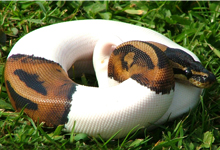 |
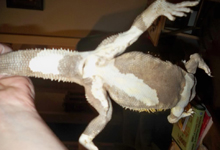 |
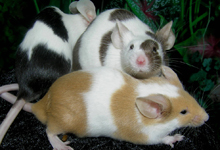 |
 |
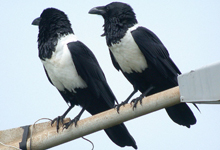 |
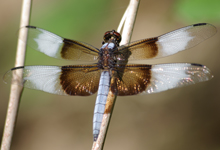 |
 |
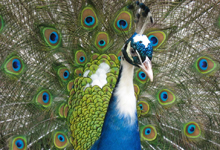 |
Piebaldism:
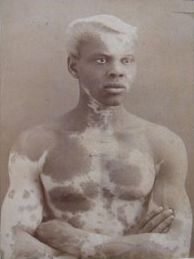 Piebald
is a word often used to describe animals with large black and white
spots; however, it is also used to describe human beings with this
unusual skin condition. It might come surprising to many of you that
there are
also piebald humans. In humans, piebaldism is a rare autosomal dominant
disorder of melanocyte development characterized by patches of lack
of pigmentation in the skin and the hair. Because
piebaldism is an autosomal dominant genetic disorder, half of an
affected
person's children will also have the condition. The word piebald
itself has
been
attributed to a combination of the "pie" in the magpie (a
bird of black and white plumage) and the "bald" of the bald
eagle (the United States' national bird, which has a white feathered
head).
Piebald
is a word often used to describe animals with large black and white
spots; however, it is also used to describe human beings with this
unusual skin condition. It might come surprising to many of you that
there are
also piebald humans. In humans, piebaldism is a rare autosomal dominant
disorder of melanocyte development characterized by patches of lack
of pigmentation in the skin and the hair. Because
piebaldism is an autosomal dominant genetic disorder, half of an
affected
person's children will also have the condition. The word piebald
itself has
been
attributed to a combination of the "pie" in the magpie (a
bird of black and white plumage) and the "bald" of the bald
eagle (the United States' national bird, which has a white feathered
head).
Although piebaldism may visually appear to be partial albinism, piebaldism differs from albinism in that the affected cells maintain the ability to produce pigment, but have that specific function turned off. In albinism the cells lack the ability to produce pigment all together. Piebalding caused by dominant mutations of an altogether different set of genes is a condition known as Vitiligo - a condition that causes depigmentation of sections of skin.
This striking phenotype of depigmented patches of skin and hair has been observed throughout history of humans, with the first descriptions dating to early Egyptian, Greek, and Roman writings. Generation after generation demonstrated a distinctive predictable familial mark -- a white forelock. Piebald people were the subject of most of early medical history -- unfortunately most of that history is filled with racist statements and ignorance towards piebald individuals.
Piebaldism disorder affects
all races with equal gender distribution. However, persons of African
heritage
with piebaldism make up
the bulk – often called leopard or zebra
people. Patients of this genetic disorder condition are at risk
of sunburn and other
disorders caused by overexposure to the sun. In humans, there are several
piebalds. Common characteristics include a congenital white forelock,
scattered normal pigmented
and hyperpigmented macules, and a triangular depigmented
patch on
the forehead. There is one form where the skin on the arms and torso
is pretty much totally pigment free with small areas with pigment.
This condition is present at birth and those pigmented areas tend to
grow pretty dramatically with age and are permanent. Rare case
reports have found associations with
Hirschsprung's disease, mental retardation, deafness, and cerebellar
ataxia. Patients generally have a normal life span. The skin depigmentation
in piebaldism is unresponsive to medical treatments and phototherapy.
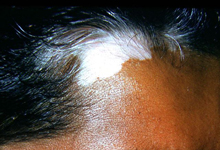 |
 |
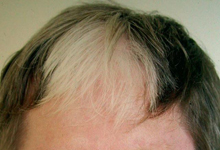 |
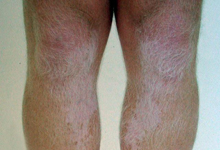 |
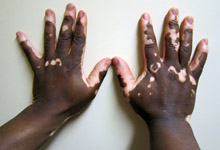 |
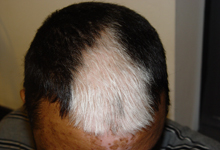 |
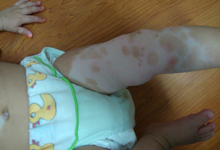 |
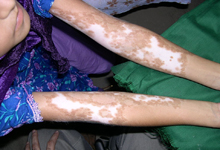 |
“Leukoderma” (“white skin”) is a generic term for piebaldism that occurs during an animal’s lifetime (“acquired depigmentation”). It is usually progressive and is sometimes triggered by illness or environmental factors. Piebaldism in humans is due to an absence of melanocytes in affected skin and hair follicles. This is caused by mutations of the KIT proto-oncogene. Fourteen point mutations, nine deletions, two nucleotide splice mutations, and three insertions of the KIT gene are believed to be mutations causing piebaldism. The severity of the condition correlates with the site of the mutation within the KIT gene. According to Dr. Hazan, piebaldism in humans results from a mutation in the c-kit proto-oncogene, which is located on chromosome 4q12. The c-kit proto-oncogene encodes for the cell-surface tyrosine-kinase receptor, whose ligand is a stem cell and mast cell growth factor.
References:
1. Cryberg, R.
PhD. (2006) Biosynthesis of eumelanins and pheomelanin.
2. Cryberg, R. PhD. private communication.
3. Fulton, R. L. (1895). Fulton's book of pigeons, with standards
for judging. p.172.
4. Hazan, C. MD. (2005). Piebaldism. Dermatology Online Journal 11 (4):
18 Department of Dermatology, New York University School of Medicine.
5. Hollander, W. F. (1983). Origins and excursions in pigeon genetics:
a compilation. Burrton, Kan.: The Ink Spot.
6. Hollander, W. F. and Miller, W. J. (1979). The story of the pied mutation.
American Dove Association Newsletter, Jan-Feb.
7. Levi, W. M. (1963). The pigeon (2d ed.). Sumter, S.C.: Levi Pub. Co.
8. Mangile, R. J. Evidence suggesting allelism of “Gazzi” and “Recessive
White” in Pigeons.
9. Mangile, R. J. private communication.
10. Quinn, Joe W. (1971). The pigeon Breder’s Notebook. QB&Q
Publishing.
Copyright August, 2011 by Arif Mümtaz